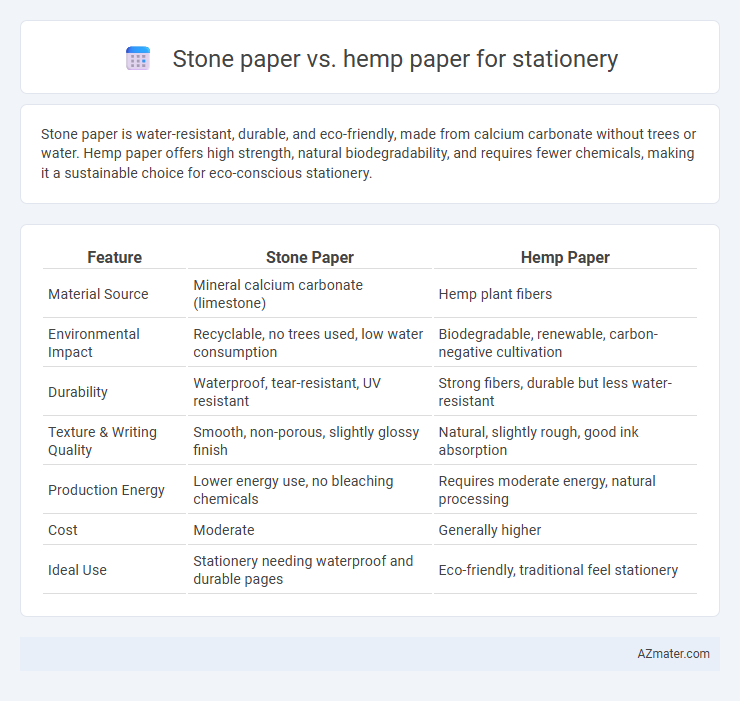Stone paper is water-resistant, durable, and eco-friendly, made from calcium carbonate without trees or water. Hemp paper offers high strength, natural biodegradability, and requires fewer chemicals, making it a sustainable choice for eco-conscious stationery.
Table of Comparison
| Feature | Stone Paper | Hemp Paper |
|---|---|---|
| Material Source | Mineral calcium carbonate (limestone) | Hemp plant fibers |
| Environmental Impact | Recyclable, no trees used, low water consumption | Biodegradable, renewable, carbon-negative cultivation |
| Durability | Waterproof, tear-resistant, UV resistant | Strong fibers, durable but less water-resistant |
| Texture & Writing Quality | Smooth, non-porous, slightly glossy finish | Natural, slightly rough, good ink absorption |
| Production Energy | Lower energy use, no bleaching chemicals | Requires moderate energy, natural processing |
| Cost | Moderate | Generally higher |
| Ideal Use | Stationery needing waterproof and durable pages | Eco-friendly, traditional feel stationery |
Introduction to Stone Paper and Hemp Paper
Stone paper, made from calcium carbonate bonded with non-toxic resin, offers a durable, waterproof, and tear-resistant alternative to traditional paper, ideal for stationery requiring longevity. Hemp paper, derived from the fibers of the hemp plant, is eco-friendly, biodegradable, and features high tensile strength, making it a sustainable choice for stationery materials. Both options provide unique benefits in durability and environmental impact, positioning them as innovative competitors to conventional wood-pulp paper.
Raw Material Origins: Stone vs Hemp
Stone paper originates from calcium carbonate, primarily sourced from abundant limestone deposits, making it a sustainable alternative with minimal water usage and no trees required. Hemp paper derives from the fast-growing fibers of the hemp plant, known for its high cellulose content and rapid cultivation cycle, enabling eco-friendly production with reduced pesticide dependency. Both raw materials support environmentally conscious stationery choices by offering renewable and resource-efficient options compared to traditional wood pulp paper.
Manufacturing Processes Compared
Stone paper is manufactured by combining calcium carbonate with non-toxic resin through an eco-friendly process that requires no water or tree cutting, resulting in a durable and waterproof material. Hemp paper production involves pulping hemp fibers, which requires less water and fewer chemicals than traditional wood pulp methods, and offers a fast-growing crop source that enhances sustainability. Both manufacturing processes emphasize environmental benefits, but stone paper's resin coating provides superior water resistance while hemp paper maintains a natural fiber texture preferred for eco-conscious stationery.
Environmental Impact: Sustainability Analysis
Stone paper is made from calcium carbonate bonded with non-toxic resin, eliminating the need for water, trees, and harsh chemicals, which significantly reduces its environmental footprint compared to traditional wood-pulp paper. Hemp paper, derived from the fast-growing hemp plant, requires less water and pesticides than conventional tree-based paper and offers superior biodegradability and recyclability, making it a sustainable choice for eco-friendly stationery. Both materials reduce deforestation and pollution, but stone paper's durability and zero water usage offer a distinct advantage in minimizing environmental impact over time.
Durability and Water Resistance
Stone paper offers superior durability and water resistance compared to traditional hemp paper, making it ideal for stationery exposed to moisture or frequent handling. Manufactured from calcium carbonate bonded with non-toxic resin, stone paper resists tearing and does not warp when wet, unlike hemp paper which may weaken and degrade over time due to its fibrous nature. Hemp paper remains eco-friendly but falls short in water resistance and long-term durability, making stone paper a preferred choice for high-performance stationery products.
Writing Experience and Texture
Stone paper offers a smooth, waterproof surface that enhances ink flow and reduces smudging, making it ideal for a consistent writing experience. Hemp paper features a naturally coarse texture that provides excellent grip for pens and pencils, appealing to those who prefer tactile feedback while writing. Both materials are durable, but stone paper's synthetic composition delivers a slick finish, whereas hemp paper's fibrous texture lends an organic feel.
Cost and Market Availability
Stone paper typically costs 20-30% more than hemp paper due to its unique manufacturing process involving crushed limestone and non-toxic resins, but it offers greater durability and water resistance. Hemp paper, derived from fast-growing hemp fibers, is generally more affordable and widely available in markets focused on sustainable and eco-friendly stationery. Both materials face limited but growing availability compared to traditional wood pulp paper, with hemp paper currently having broader distribution in North America and Europe.
Printing and Ink Compatibility
Stone paper offers excellent ink adherence due to its smooth, non-porous surface, resulting in vibrant, smudge-resistant prints ideal for high-quality stationery. Hemp paper, with its natural fiber texture, provides a more absorbent surface that works well with soybean-based and water-based inks, producing earthy tones but sometimes leading to slight ink diffusion. Printing on stone paper generally requires specialized techniques for optimal ink bonding, whereas hemp paper accommodates standard printing methods with eco-friendly ink options.
Recycling and Biodegradability
Stone paper, made from calcium carbonate and non-toxic resins, offers water resistance and durability but poses challenges for traditional recycling processes due to its mineral composition. Hemp paper, derived from sustainable cannabis fibers, is highly biodegradable and easily recyclable, making it an eco-friendly choice for stationery. The biodegradability and recyclability of hemp paper significantly reduce environmental impact compared to stone paper's limited recyclability and longer decomposition time.
Choosing the Right Paper for Stationery
Stone paper offers exceptional durability and water resistance, making it ideal for notebooks and planners that require longevity and tear resistance. Hemp paper provides a sustainable and eco-friendly alternative with natural strength and a textured feel, appealing to environmentally conscious consumers. Choosing the right paper for stationery depends on balancing durability, sustainability, and the intended use, with stone paper excelling in robustness and hemp paper leading in biodegradability.

Infographic: Stone paper vs Hemp paper for Stationery
 azmater.com
azmater.com